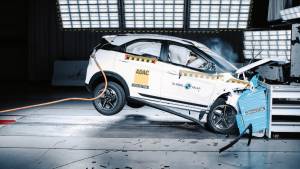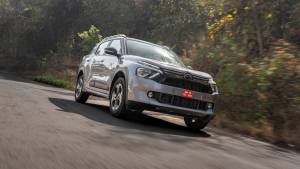Increased Safety Thanks to Anticipatory Technology: The Continental eHorizon and PreviewESC Systems
Frankfurt am Main, Germany, July 31, 2019. The route is unfamiliar and the weather unsettled, leaving the road surface dry at times and then wet again. For drivers, unpredictable road conditions such as these require maximum concentration. To increase safety and comfort in the future, drivers will receive even more effective support from their vehicles. Technology company Continental has developed a function that enables cars to take pre-emptive action against potential risks. Thanks to matched sensors, data processing, and assistance systems, the vehicle knows exactly how fast to travel to ensure a journey that is both speedy and safe, as it anticipates what to expect from the bends and road surface conditions ahead.
Continental eHorizon functions as an anticipatory, virtual sensor
To achieve a new level of safety on the way to Vision Zero, the vision of accident-free driving, Continental is now networking several well-established technologies. The Road Condition Observer, for example, uses the systems already present in the vehicle, such as the Electronic Stability Control (ESC) and camera systems, to classify the road conditions as dry, wet, very wet (risk of aquaplaning), snow-covered or icy. Using an estimated friction coefficient based on this classification, it is possible to predict how well the tires will grip the respective section of road. The Road Condition Observer continuously transmits the friction coefficient data in near-time to the Continental.cloud, where information on the friction coefficients of other vehicles as well as weather data, such as temperature and precipitation, are also collected. Also in the cloud, eHorizon processes the data collected from the entire vehicle fleet with the aid of artificial intelligence and other technologies, which again increases the reliability of the predictions. Continental uses artificial intelligence, for example, to create models which are able to detect road objects and predict arising hazardous situations. These models can react to changing conditions and use input and output data to adjust functions through learning tasks. Additionally, neural networks are used for image processing and object detection.
The appropriate data packages with all the relevant information are then transmitted back to the vehicles which are currently traveling along the relevant section of road. In the car, in turn, the eHorizon client receives and processes this data. "Think of the eHorizon as an additional, virtual sensor that networks data from various different sources, assesses it intelligently and relays it to other vehicles. We are thereby taking road safety to a new level under all conditions," says Anton Klöster, eHorizon product manager at Continental.
Today, eHorizon is already available in commercial vehicles, successfully supporting truck drivers in achieving better fuel economy and enabling automated driving functions. However, evaluation of the road conditions is entirely new. In the future, as soon as it is possible to use the data from the Road Condition Observer to create dynamic friction coefficient maps, eHorizon will include this new information in its calculations for greater road safety and comfort. It successfully combines swarm intelligence (many cars reporting up-to-date information on friction coefficients from many roads), weather data, and information on road surface conditions from additional sources to provide accurate predictions. eHorizon therefore has extremely accurate knowledge of the road ahead, as well as a precise understanding, not only of its static properties (curve radii, gradients, slopes) as in the past, but also of the current road conditions.
DISCLAIMER: This information is published as per the press release sent to us. It has not been verified or ratified by OVERDRIVE.











